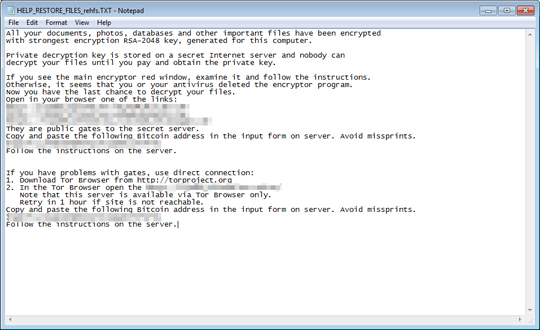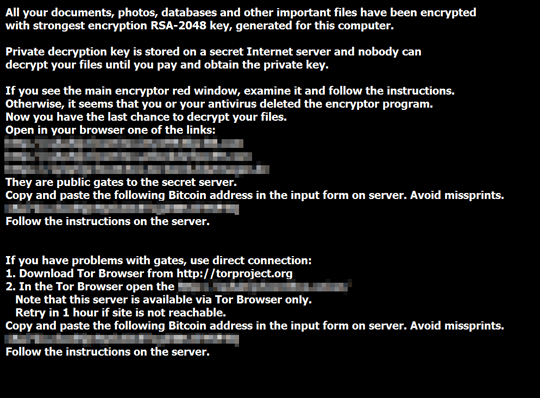RANSOM_CRYPTESLA.XXQQ
Trojan.Deshacop.Win32.53 (Zillya), Trojan.Win32.Deshacop.eo (Kaspersky), Trojan.Win32.Filecoder (Ikarus)
Windows


Threat Type: Trojan
Destructiveness: No
Encrypted: No
In the wild: Yes
OVERVIEW
This Trojan arrives on a system as a file dropped by other malware or as a file downloaded unknowingly by users when visiting malicious sites.
It modifies the Internet Explorer Zone Settings.
It deletes the initially executed copy of itself.
TECHNICAL DETAILS
Arrival Details
This Trojan arrives on a system as a file dropped by other malware or as a file downloaded unknowingly by users when visiting malicious sites.
Installation
This Trojan drops the following copies of itself into the affected system and executes them:
- %AppDataLocal%\{random filename}.exe
(Note: %AppDataLocal% is the Application Data folder found in Local Settings, where it is usually C:\Documents and Settings\{user name}\Local Settings\Application Data on Windows 2000, Windows Server 2003, and Windows XP (32- and 64-bit); C:\Users\{user name}\AppData\Local on Windows Vista (32- and 64-bit), Windows 7 (32- and 64-bit), Windows 8 (32- and 64-bit), Windows 8.1 (32- and 64-bit), Windows Server 2008, and Windows Server 2012.)
It drops the following files:
- %AppDataLocal%\log.html - contains the list of encrypted files
- %Desktop%\Save_Files.lnk - shortcut pointing to the dropped copy
- %Desktop%\HELP_RESTORE_FILES.bmp
- %Desktop%\HELP_RESTORE_FILES.txt
- %User Profile%\Documents\RECOVERY_FILE.txt
- %AppDataLocal%\GDIPFONTCACHEV1.DAT
- {Folders of all files encrypted}\HELP_RESTORE_FILES_{random 5 letters}.TXT
(Note: %AppDataLocal% is the Application Data folder found in Local Settings, where it is usually C:\Documents and Settings\{user name}\Local Settings\Application Data on Windows 2000, Windows Server 2003, and Windows XP (32- and 64-bit); C:\Users\{user name}\AppData\Local on Windows Vista (32- and 64-bit), Windows 7 (32- and 64-bit), Windows 8 (32- and 64-bit), Windows 8.1 (32- and 64-bit), Windows Server 2008, and Windows Server 2012.. %Desktop% is the desktop folder, where it usually is C:\Documents and Settings\{user name}\Desktop in Windows 2000, Windows Server 2003, and Windows XP (32- and 64-bit); C:\Users\{user name}\Desktop in Windows Vista (32- and 64-bit), Windows 7 (32- and 64-bit), Windows 8 (32- and 64-bit), Windows 8.1 (32- and 64-bit), Windows Server 2008, and Windows Server 2012.. %User Profile% is the current user's profile folder, which is usually C:\Documents and Settings\{user name} on Windows 2000, XP, and Server 2003, or C:\Users\{user name} on Windows Vista and 7.)
It adds the following mutexes to ensure that only one of its copies runs at any one time:
- safsdfasdfwrtqr15
Autostart Technique
This Trojan adds the following registry entries to enable its automatic execution at every system startup:
HKEY_CURRENT_USER\Software\Microsoft\
Windows\CurrentVersion\Run
AVrSvc = %AppDataLocal%\{random filename}.exe
HKEY_LOCAL_MACHINE\SOFTWARE\Microsoft\
Windows\CurrentVersion\Run
AVrSvc = %AppDataLocal%\{random filename}.exe
Other System Modifications
This Trojan modifies the following registry entries:
HKEY_CURRENT_USER\Control Panel\Desktop
WallpaperStyle = 0
(Note: The default value data of the said registry entry is {User Preferences}.)
HKEY_CURRENT_USER\Control Panel\Desktop
TileWallpaper = 0
(Note: The default value data of the said registry entry is {User Preferences}.)
HKEY_CURRENT_USER\Control Panel\Desktop
Wallpaper = %Desktop%\HELP_RESTORE_FILES.bmp
(Note: The default value data of the said registry entry is {User Preferences}.)
It sets the system's desktop wallpaper to the following image:
Backdoor Routine
This Trojan connects to the following URL(s) to send and receive commands from a remote malicious user:
- {BLOCKED}egu6hn.tor2web.{BLOCKED}gie.de:443
- {BLOCKED}egu6hn.{BLOCKED}s4we39.com
- {BLOCKED}egu6hn.{BLOCKED}kjc38.com
- {BLOCKED}egu6hn.{BLOCKED}b.org
Process Termination
This Trojan terminates processes or services that contain any of the following strings if found running in the affected system's memory:
- taskmgr
- procexp
- regedit
- msconfig
- cmd.exe
Web Browser Home Page and Search Page Modification
This Trojan modifies the Internet Explorer Zone Settings.
Other Details
This Trojan connects to the following URL(s) to get the affected system's IP address:
- http://ipinfo.io/ip
It encrypts files with the following extensions:
- .3fr
- .7z
- .accdb
- .ai
- .apk
- .arch00
- .arw
- .asset
- .avi
- .bar
- .bay
- .bc6
- .bc7
- .bigwallet
- .bik
- .bkf
- .bkp
- .blob
- .bsa
- .cas
- .cdr
- .cer
- .cfr
- .cr2
- .crt
- .crw
- .css
- .csv
- .d3dbsp
- .das
- .dazip
- .db0
- .dba
- .dbf
- .dcr
- .der
- .desc
- .dmp
- .dng
- .doc
- .docm
- .docx
- .dwg
- .dxg
- .epk
- .eps
- .erf
- .esm
- .ff
- .flv
- .forge
- .fos
- .fpk
- .fsh
- .gdb
- .gho
- .hkdb
- .hkx
- .hplg
- .hvpl
- .ibank
- .icxs
- .indd
- .itdb
- .itl
- .itm
- .iwd
- .iwi
- .jpe
- .jpeg
- .jpg
- .js
- .kdb
- .kdc
- .kf
- .layout
- .lbf
- .litemod
- .lrf
- .ltx
- .lvl
- .m2
- .m3u
- .m4a
- .map
- .mcmeta
- .mdb
- .mdbackup
- .mddata
- .mdf
- .mef
- .menu
- .mlx
- .mov
- .mp4
- .mpqge
- .mrwref
- .ncf
- .nrw
- .ntl
- .odb
- .odc
- .odm
- .odp
- .ods
- .odt
- .orf
- .p12
- .p7b
- .p7c
- .pak
- .pdd
- .pef
- .pem
- .pfx
- .pkpass
- .png
- .ppt
- .pptm
- .pptx
- .psd
- .psk
- .pst
- .ptx
- .py
- .qdf
- .qic
- .r3d
- .raf
- .rar
- .raw
- .rb
- .re4
- .rgss3a
- .rim
- .rofl
- .rtf
- .rw2
- .rwl
- .sav
- .sb
- .sid
- .sidd
- .sidn
- .sie
- .sis
- .slm
- .snx
- .sql
- .sr2
- .srf
- .srw
- .sum
- .svg
- .syncdb
- .t12
- .t13
- .tax
- .tor
- .txt
- .upk
- .vcf
- .vdf
- .vfs0
- .vpk
- .vpp_pc
- .vtf
- .w3x
- .wb2
- .wma
- .wmo
- .wmv
- .wotreplay
- .wpd
- .wps
- .x3f
- .xf
- .xlk
- .xls
- .xlsb
- .xlsm
- .xlsx
- .xxx
- .zip
- .ztmp
It renames encrypted files using the following names:
- {Original Filename}.exx
It deletes the initially executed copy of itself
NOTES:
This malware encrypts files in all fixed, removable, and network drives and shares. It deletes shadow copies by executing the following command:
- vssadmin.exe delete shadows /all /Quiet
It displays the following message box which informs the user of what happened to the user's files and how to restore them.

It drops a text file in all the folders of the files it successfully encrypts.

SOLUTION
Step 1
Before doing any scans, Windows XP, Windows Vista, and Windows 7 users must disable System Restore to allow full scanning of their computers.
Step 2
Note that not all files, folders, and registry keys and entries are installed on your computer during this malware's/spyware's/grayware's execution. This may be due to incomplete installation or other operating system conditions. If you do not find the same files/folders/registry information, please proceed to the next step.
Step 3
Identify and terminate files detected as RANSOM_CRYPTESLA.XXQQ
- Windows Task Manager may not display all running processes. In this case, please use a third-party process viewer, preferably Process Explorer, to terminate the malware/grayware/spyware file. You may download the said tool here.
- If the detected file is displayed in either Windows Task Manager or Process Explorer but you cannot delete it, restart your computer in safe mode. To do this, refer to this link for the complete steps.
- If the detected file is not displayed in either Windows Task Manager or Process Explorer, continue doing the next steps.
Step 4
Delete this registry value
Important: Editing the Windows Registry incorrectly can lead to irreversible system malfunction. Please do this step only if you know how or you can ask assistance from your system administrator. Else, check this Microsoft article first before modifying your computer's registry.
- In HKEY_CURRENT_USER\Software\Microsoft\Windows\CurrentVersion\Run
- AVrSvc = %AppDataLocal%\{random filename}.exe
- AVrSvc = %AppDataLocal%\{random filename}.exe
- In HKEY_LOCAL_MACHINE\SOFTWARE\Microsoft\Windows\CurrentVersion\Run
- AVrSvc = %AppDataLocal%\{random filename}.exe
- AVrSvc = %AppDataLocal%\{random filename}.exe
Step 5
Restore this modified registry value
Important: Editing the Windows Registry incorrectly can lead to irreversible system malfunction. Please do this step only if you know how or you can ask assistance from your system administrator. Else, check this Microsoft article first before modifying your computer's registry.
- In HKEY_CURRENT_USER\Control Panel\Desktop
- From: WallpaperStyle = "0"
To: WallpaperStyle = {User Defined}
- From: WallpaperStyle = "0"
- In HKEY_CURRENT_USER\Control Panel\Desktop
- From: TileWallpaper = "0"
To: TileWallpaper = {User Defined}
- From: TileWallpaper = "0"
- In HKEY_CURRENT_USER\Control Panel\Desktop
- From: Wallpaper = %Desktop%\HELP_RESTORE_FILES.bmp
To: Wallpaper = {User Defined}
- From: Wallpaper = %Desktop%\HELP_RESTORE_FILES.bmp
Step 6
Search and delete this file
- %AppDataLocal%\log.html
- *%User Profile%\Documents\RECOVERY_FILE.txt
- %Desktop%\Save_Files.lnk
- %Desktop%\HELP_RESTORE_FILES.bmp
- %Desktop%\HELP_RESTORE_FILES.txt
- %AppDataLocal%\GDIPFONTCACHEV1.DAT
- {Folders of all files encrypted}\HELP_RESTORE_FILES_{random 5 letters}.TXT
Step 7
Scan your computer with your Trend Micro product to delete files detected as RANSOM_CRYPTESLA.XXQQ. If the detected files have already been cleaned, deleted, or quarantined by your Trend Micro product, no further step is required. You may opt to simply delete the quarantined files. Please check this Knowledge Base page for more information.
Did this description help? Tell us how we did.



